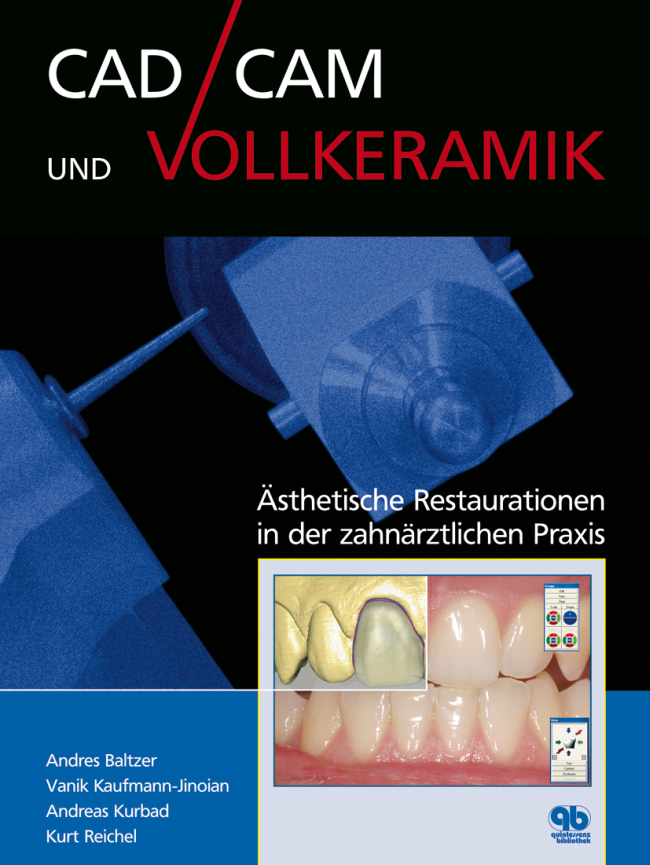QZ - Quintessenz Zahntechnik, 2/2017
StatementPages 132-142, Language: GermanBaltzer, Andres / Hohermuth, Christian / Kaufmann, VanikVorgehen in Klinik und LaborDie Gestaltung einer therapeutischen Schiene ist traditionell mit einem möglicherweise abschreckenden Aufwand verbunden. Sie beginnt mit der Herstellung von Meister- und Arbeitsmodellen, auf welchen einerseits die Apparaturen für die Registrierung der Artikulationsparameter und andererseits die Schiene selbst gefertigt werden müssen. Einiges an Aufwand lässt sich mit der konsequent digital gehaltenen Arbeitsweise einsparen. Der Beitrag zeigt die CAD/CAM-gestützte Fertigung in drei Schritten.
Keywords: CAD/CAM-Fertigung, Michigan-Schiene, 3-D-Druck, Artikulation, Okklusion
QZ - Quintessenz Zahntechnik, 5/2014
Case ReportPages 614-619, Language: GermanHohermuth, Christian / Buser, Stefan / Baltzer, Monika / Baltzer, Andres / Kaufmann-Jinoian, VanikDie Autoren stellen die seit 2013 auf dem Markt befindliche zirkonoxidverstärkte Lithiumsilikat-Keramik VITA SUPRINITY vor, mit der sie regelmäßig arbeiten. Anhand einer Fallbeschreibung berichten sie über ihre Erfahrungen nach knapp einem Jahr mit dem neuen Material und geben Tipps zu seiner Bearbeitung.
Keywords: Keramik, Lithiumdisilikat, zirkonoxidverstärkte Lithiumsilikat-Keramik, VITA SUPRINITY, CAD/CAM, Bearbeitungstipps
QZ - Quintessenz Zahntechnik, 2/2013
StatementPages 190-196, Language: GermanBaltzer, AndresDer Beitrag stellt das neue Hybridmaterial VITA ENAMIC (VITA Zahnfabrik, Bad Säckingen) vor, das aus einer keramischen Matrix besteht, deren Poren mit einem Polymermaterial gefüllt sind. Der Autor erläutert das neuartige Werkstoffkonzept und berichtet über seine Erfahrungen mit dem Werkstoff in der Praxis anhand eines Patientenfalls, der mit diesem Material gelöst wurde.
Keywords: Hybridmaterial, VITA ENAMIC, CAD/CAM, Veneers, Materialdaten
International Journal of Computerized Dentistry, 3/2008
PubMed ID (PMID): 19216315Pages 241-256, Language: English, GermanBaltzer, AndresThe shape of a crown preparation is the prime determinant for the choice of material for an all-ceramic restoration. One essential factor is the available space for the restoration, which requires a certain occlusal thickness. The dentist's preparation design determines the available vertical clearance, and the dental technician has the responsibility of advising the dentist with regard to either choosing the right material to match the preparation or to preparing the tooth to match the material. Assuming a minimum static fracture strength of > 2000 N, the following materials can be used for all-ceramic crowns. Laboratory surveys have shown that in most situations, the available occlusal clearance in clinical reality is only 0.8 to 0.9 mm (after cementing). This shows that the available space will often be insufficient for providing monoblock crowns and still on the tight side for veneered oxide ceramics (In Ceram, zirconia, etc.). However, crowns made of veneered oxide ceramics are much more complex to fabricate and much more expensive. By simply providing a minimal occlusal thickness of 1.5 mm, the treatment provider could therefore easily facilitate the use of the much more economical monoblock crowns without compromising either esthetics or strength. Actually, crowns with veneered oxide ceramic copings do not offer any higher fracture resistance compared to Mark II crowns as long as the minimum thickness requirements are met. The flexural strength of CAD/CAM-fabricated lithium disilicate rods is about twice that of CAD/CAM-fabricated Mark II rods. When used for crowns with a wall thickness of 1.5 mm, however, both materials exhibit the same fracture strength of between 2000 and 2500 N. This is related to the different reinforcing action of the adhesive luting agent, which is essentially required for both these materials. When choosing a material, preparation shapes, technical complexity and cost should be thoroughly compared and scrutinized and should figure prominently in the discussions between dentists and dental technician. Unfavorable preparation shapes for single crowns will necessitate compromises in terms of the choice of materials that result in high cost but do not offer anything in the way of higher fracture resistance. What constitutes an appropriate all-ceramic restoration for a single tooth? Do all-ceramic single crowns require the same material bulk as multi-unit bridges? Everything would indicate that a suitable preparation geometry allows feldspathic ceramic monoblock crowns to be milled that do not require any extensive finishing efforts such as thermal annealing or in-laboratory veneering while at the same time demanding no compromises in terms of esthetics and load-bearing capacity.
International Journal of Computerized Dentistry, 1/2007
PubMed ID (PMID): 17455773Pages 99-103, Language: English, GermanBaltzer, Andres / Kaufmann-Jinoian, V.VITA CAD-Temp is a composite block which enables highquality provisional restorations to be created using the Sirona milling units. The new Cerec MC XL and inLab MC XL units are the preferred choice on account of their significantly higher milling speeds. The technical requirements are described and an illustrated practical example presented. CAD-Temp constitutes a good example of rapid and efficient collaboration between dentists and dental technicians. This is illustrated on the basis of an example relating to the field of implant prosthetics.
Keywords: Cerec, inLab, CAD/CAM material, provisional restoration, CAD-Temp
International Journal of Computerized Dentistry, 2/2005
Pages 129-152, Language: English, GermanBaltzer, Andres/Kaufmann-Jinoian, V.In the 1990s, there was great optimism due to the development of devices for measuring tooth shade. The frequently not so simple, visual determination of the shade of a tooth was to be done with the aid of a device which recognizes the shade and describes it accurately by reference to a color chart. However, the skepticism towards such devices was also great. It is known that the color effect frequently differs strongly when comparing a tooth from the shade guide with a metal ceramic crown, despite identical shade designation. Anyone who considers visual shade determination to be inadequate and places his hopes in digital shade matching devices will be disappointed. It is the shade-generating structures of the metal ceramic and frequently of the veneer layers that turn out to be too thin which, despite correct shade selection, cause a different color perception. Such problems have been reduced decisively with the development of fracture- proof hard porcelain caps (Vita In- Ceram) with optical characteristics similar to teeth. In addition, the Vita System 3D-Master tooth shade system developed in 1998 by Vita in cooperation with Dr. Hall from Australia, leads the practitioner to a better understanding of the primary tooth shade characteristics of "brightness (value)", "color intensity (chroma)" and "color (wave length of the visible light, hue)". These two innovations allow a more accurate estimate of the basic shade of a natural tooth (reference tooth) and the imitation in the laboratory of its natural, shade-generating structures. If digital shade measurement supplements the visual shade estimate, then a further improvement can be expected - especially in the recognition of the basic shade.
Qualitative descriptions of subjective shade measurement of a natural tooth and of its imitation in the dental laboratory by ceramics can be found frequently in professional journals and publications. With digital tooth shade matching devices, which apart from the color code of the color chart also reproduce exact, colorimetric values, such work processes can be recorded quantitatively and objectively. Reports about this type of controlled shade determination and generation are found rarely in the literature, which is surprising in view of the large number of tooth shade matching devices and dental ceramic systems available. In the present paper, the influence of the individual ceramic layers on color perception is measured and described under standardized conditions. The creation of the basic shade as it results from the composition of the various ceramic layers is traced with a spectrophotometer. The Vita In-Ceram Alumina infiltration ceramic and the VitaVM7 veneer ceramic were selected as the ceramic system. MHTSpectroShade and Vita Easyshade were used as shade matching devices.
Keywords: In-Ceram, all-ceramic, veneering ceramic, Vita VM7, tooth shades, digital color measurement
QZ - Quintessenz Zahntechnik, 8/2004
BasicsPages 834-858, Language: GermanBaltzer, Andres / Kaufmann-Jinoian, VanikEinzelzahnrekonstruktionen im Frontzahnbereich stellen eine anspruchsvolle Aufgabe dar. Die Rekonstruktion soll den Nachbarzähnen so angeglichen werden, dass sie sich weder in Form noch Farbe abheben. Oft beeinflussen individuelle Eigenheiten des Referenzzahnes wie beispielsweise Oberflächenbeschaffenheit, Haarrisse, Transparenzzonen usw. die richtige Erkennung der Grundfarbe. Mit digitalen Zahnfarbenmessgeräten können solche Schwierigkeiten entschärft werden. Nach der Dokumentation der individuellen Effekte des Referenzzahnes ergänzt die digitale Messung der Grundfarbe des Zahnes die visuelle Farbbestimmung hervorragend, minimiert Fehlentwicklungen, verhindert rechtzeitig Farbabweichungen und lästige Wiederholungsarbeiten.
Keywords: CEREC, CAD/CAM, VITA SYSTEM 3D-MASTER, Zahnfarben, Farbenlehre, Kolorimetrie, Fotospektrometrie, digitale Farbmessung
QZ - Quintessenz Zahntechnik, 7/2004
BasicsPages 726-740, Language: GermanBaltzer, Andres/Kaufmann-Jinoian, VanikUm bei der Farbbestimmung der Zähne eine Systematisierung und eine noch höhere Trefferquote zu erreichen, entstand das VITA SYSTEM 3D-MASTER®. Es beruht auf der konsequenten Übernahme der modernen Farbenlehre. Ein Einblick in die Entwicklung eines Farbenraums, in welchem die Farbunterschiede numerisch bestimmt werden, erleichtert das Verständnis für den Farbenraum, in welchem sich alle in der Natur vorkommenden Zahnfarben finden. Im VITA SYSTEM 3D-MASTER® wird dieser Zahnfarbenraum in fünf Helligkeitsgruppen aufgeteilt. Bei der Farbbestimmung wird vorerst die zutreffende Helligkeitsgruppe bestimmt, innerhalb der anschließend die übrigen Farbcharakteristika zugeordnet werden.
Keywords: CEREC, CAD/CAM, VITA SYSTEM 3D-MASTER®, Zahnfarben, Farbenlehre
QZ - Quintessenz Zahntechnik, 10/2004
BasicsPages 1108-1117, Language: GermanBaltzer, Andres / Kaufmann-Jinoian, VanikDie Vita hat für die In-Ceram-Gerüstkeramiken Angaben zu deren minimalen Wandstärken und Konnektorenflächen veröffentlicht. Sie sollten nicht unterschritten werden. Fallstudien erlauben den Hinweis, dass sie in den meisten Fällen eher größer als minimal gefordert gestaltet werden können, ohne dabei funktionelle und ästhetische Anforderungen zu vernachlässigen. Um die größtmögliche Bruchsicherheit zu erhalten, ist es unerlässlich, primär die Konnektorenhöhe zu maximieren.
Keywords: CEREC, CAD/CAM, In-Ceram, Vollkeramik, Bruchfestigkeit, Risszähigkeit, Konnektoren.
QZ - Quintessenz Zahntechnik, 5/2003
SciencePages 612-623, Language: GermanBaltzer, Andres/Kaufmann-Jinoian, VanikDa die Passgenauigkeit eines submucosal liegenden Kronenrandes auf einem Implantat für die Prognose der Rekonstruktion einen sehr wichtigen Faktor darstellt, können Diskrepanzen und Unregelmäßigkeiten beim Übergang am Kronenrand Plaqueakkumulationen verursachen und eine Periimplantitis auslösen, die schließlich zum frühzeitigen Verlust des Implantates führt.
Die Autoren zeigen auf, wie mit CEREC inLab Kronenkappen für Implantate hergestellt werden können, deren Randpassungen wesentlich besser sind als die labortechnisch gefertigter Kappen, wobei eine kleine Nachbearbeitung mit einem speziellen Aufpassgerät am Kappenrand allerdings erforderlich ist.
Keywords: CEREC, CAD/CAM, Implantatkronen, Randpassungen, Vollkeramik




